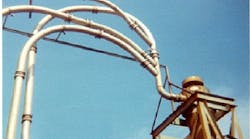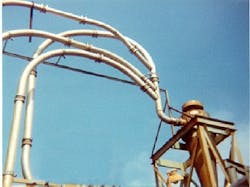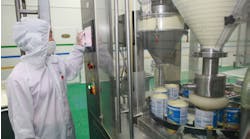Pneumatic conveying is one of the most versatile ways to move solids over moderate distances. So, not surprisingly, Chemical Processing over the years has published a number of articles (e.g., Ref. 1) on the design, installation and operation of dense- and dilute-phase pneumatic conveyors. Several models and a whole host of data from research groups also are available. However, even the best model and data can only go so far. Actual performance depends upon mechanical accuracy. For instance, a small unnoticed leak can kill the performance of a pneumatic conveyor so much for having a good model.
Additional problems may result from non-uniformity of the flow or local changes in the solids-to-air ratio.
The reality of most plant environments is that the quest to keep costs low can dictate design considerations and spell trouble, particularly when using old equipment for a new project.
However, you can take a number of steps to prevent problems.
Top 10 tips
I have found the following pointers useful both for planning new systems and modifying existing ones.
Figure 1. Sometimes no detailed analysis is needed to spot a bad layout.
Figure 2. This modification enables venting if a valve lacks a vent port.
Running a convey test
One of the most important parts of putting in a new conveying line is correct testing, especially on a new product or long layout. Most equipment manufacturers will perform a test for a nominal fee that seldom covers its real cost. Remember vendors are not clairvoyant and usually dont understand your overall process as well as you do. Some engineers arrive at a test expecting the manufacturer to guide them through the testing process and to point out what the buyer needs to do. That approach doesnt sell a lot of pneumatic conveyors, which after all is the vendors objective. Most manufacturers test setups are not research systems but demonstration devices. So, it is best to have a test plan that you and the vendor agreed upon beforehand. This may mean bringing in additional testing resources at your cost to supplement what is provided.
Pointers
- Look at particle attrition. Conduct particle sizing tests and examine the particles under a microscope.
- Attempt to find the choking and saltation velocities. Compare these to calculated values. Design the system at 1.5 times the maximum value but plan to reduce this velocity after installation (by reducing the blower flow rate).
- Run at both twice and half of the expected design velocity.
- Ensure the solids-to-air ratio is constant during the test.
- Calculate velocity along the line. This requires data on pressure and temperature.
- Roughly determine the particle-to-gas velocity along a straight section of pipe.
- Get the layout close to what is expected in the plant. Try to match elbows and lift location.
- Make some of your own measurements. This keeps the vendor honest.
- Inspect the piping. Pay attention to the type of joints, construction material, elbow R/D, feeder and collector details.
- Run a power failure test. Deliberately stop the gas flow and let the line sit overnight, if possible. Failures happen. The best place to find out their consequences is in the lab.
While following the test and designing the conveyor, enjoy the process of understanding your material. Imagine yourself running around inside the pipe. Pneumatic conveyors are powerful and the solids convey considerable force. I was reminded of that one time when every few hours we heard a clanking noise in a vertical section on a recirculation pneumatic conveying blender. We shut down the conveyor and removed the bottom elbow to find a 6-in.-long, 1-in.-diameter bolt that had made several trips through the system. Oh well!
References
1. Haraburda, S.S., 7 steps to efficient conveying, Chemical Processing, Vol. 63 (2), p. 57 (February 2000). 2. Duckworth, R.A. and H.E. Rose, Transport of Solid Particles in Liquid and Gases, Engineer, Vol. 227 (5,905), pp. 392-396, 430-433 and 478-483, London (1969).3. Jotaki, Y. and Y. Tomita, Flow in the Acceleration Region of Pneumatic Transport of Granular Solids in Vertical Pipes, Proceedings of Pneumotransport 3




